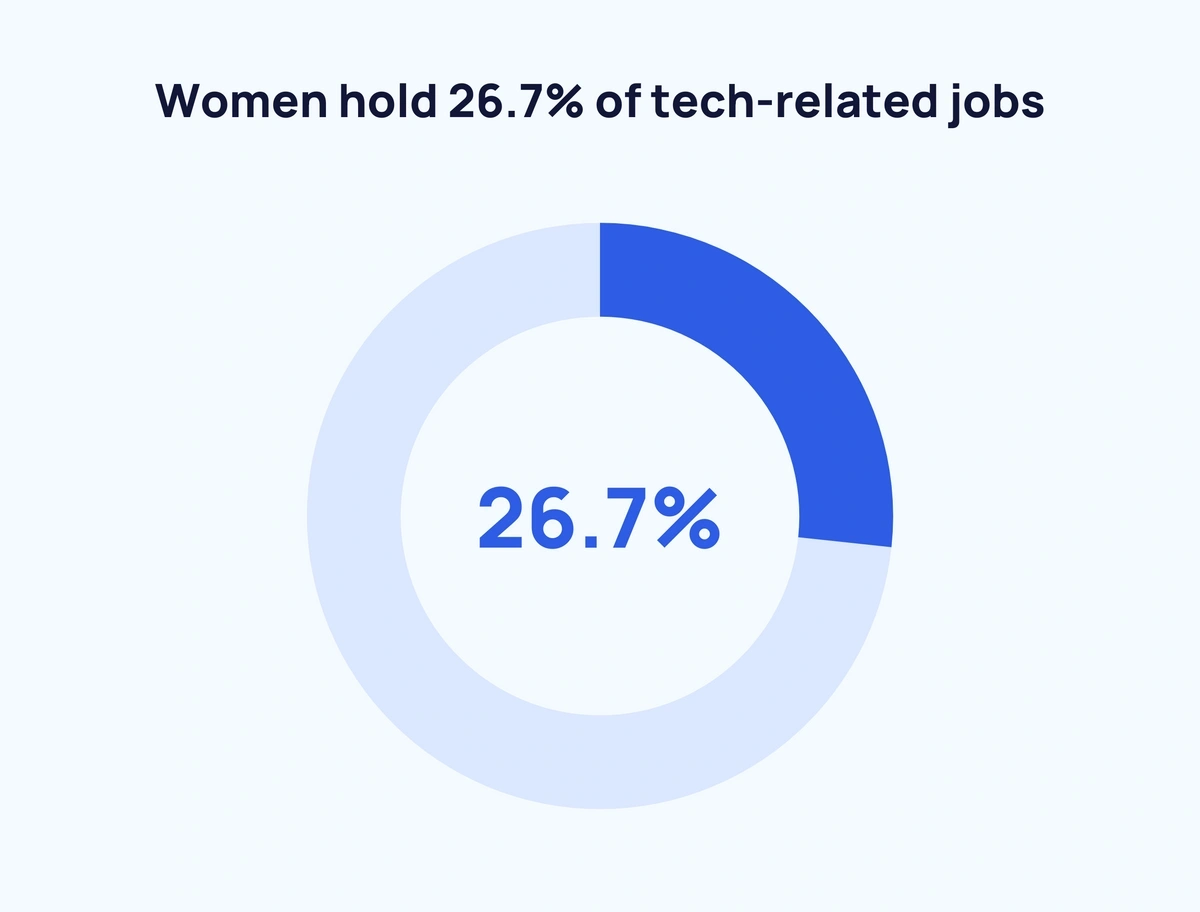Women have played an invaluable role in the advancement of technology throughout history. From Ada Lovelace – the world’s first computer programmer, and Grace Hopper who developed the first compiler for a computer programming language, women have made important contributions in technology fields worldwide.Women continue to lead technological advances today. Their contributions on everything from artificial intelligence and virtual reality applications, all the way through healthcare technology development.
Women have made tremendous advances in tech, yet more work needs to be done before reaching gender gender in this industry. Women were historically underrepresented in technology-related roles; however, recently there has been increasing recognition of diversity within this sector. Women have made considerable contributions towards software and hardware design as well as innovative solutions development. Encouraging more women to pursue careers in technology is vital; providing support and mentorship opportunities will not only promote equality but will lead to more innovative solutions from diverse viewpoints. With technology constantly shifting and evolving, creating an inclusive space for women working in this industry will only become increasingly necessary in driving innovation forward and meeting industry challenges head on.
Editor’s Choice
- Women make up only 26.7 % of tech jobs held.
- Large tech firms report an even lower representation at 26.2%.
- The percentage of women in tech careers has decreased in the last two years.
- Women working in software engineering earn 0.93 cents on every dollar men make.
- Women pursuing STEM subjects at higher education institutions is gradually decreasing, with only 18% majoring in computer science today.
- Companies providing voluntary gender diversity training tend to employ fewer female employees compared with companies offering mandatory training programs.
- Over 50% of women working in tech have reported experiencing discrimination or harassment because they are women.
- Women may receive as little as 2% of global venture capital funds and investment funds.
- The pandemic compounded the difficulties for women, with over 50% experiencing significant problems as a result of it.
- Companies which conduct intersectional pay audits tend to employ women 1.3 times more frequently.
(Source : explodingtopics)
Key Statistics
- In the United States, women make up 26% of the tech workforce.
- Globally, 32% of women are employed in the tech industry.
- Women constitute 47.70% of the total global workforce.
- At the internship level in tech, women hold 39% of the positions.
- Only 28% of women have leadership roles in tech.
- When it comes to founding tech companies, women represent 15%.
- In the STEM workforce of the United States, women make up 24%.
- About 50% of women leave tech roles by the age of 35.
- Women are 45% more likely to leave tech jobs compared to men.
- Female representation in tech varies from 43% to 48% in selected countries.
- On average, women earn 17% less than their male counterparts in the tech industry.
(Source : demandsage)
Global Tech Workforce:
- This percentage has slightly declined from 35% in 1984.
- Women make up 26% of technology occupations in the US.
- According to a 2023 CompTIA Report, 49% of US workers comprise female employees; nearly one out of every 10 tech employees is female.
- 28% of workers employed in computer and mathematical professions are women.
- United States Women Make up 23% of STEM and Engineering Workforce
- At an internship level, women occupy 39% of tech roles.
- Women currently make up 32.80% of workers employed in entry-level computer science jobs.
Global Women Workforce:
- Only 47% of working age women worldwide make up part of the global female labor force.
- Some countries experience an enormous gender disparity; only one woman works for every two men employed.
- In the United States, 57.30% of female workers participate in the workforce.
- Divorced women are significantly more likely to participate in the workforce; 63.7 % employed, as opposed to 60.8% for married women.
- Statista reported that women comprised 32.9% of global workforce in 2022.
Representation in Technical Roles:
- Women occupying technical roles globally have reached 26.7% as of 2023.
- Facebook (24%), Apple (24%), Google (25%), and Microsoft (23%). These companies all boast high representation rates of women in technical roles.

- Women occupy 26.2% of tech-related jobs at companies with more than 10,000 employees.
- American software engineers comprised 21.10% female professionals by 2023.
- 20% of women over 30 still occupy junior roles.
Women in Tech and STEM:
- Women account for 48% of STEM positions within the United States.
- Georgia boasts the highest female STEM representation at 56%.
- Women remain underrepresented in engineering (15%), computer (25%), and physical science (40%).

Women in Leadership Positions: An Exploration.
- Women’s representation in tech leadership positions fell to 28% by 2023.
- Half of women in tech leadership roles leave by age 35.
- Only 10.90% of women currently hold CEO or senior leadership roles across all employees in total workforce.
- Fortune 500 companies employ only two black women CEOs who earn 38% less than their male counterparts.
- Women now make up 18% of senior vice president positions compared to 13% back in 2019.
- Women occupy 20% of senior software engineering roles and 14.30% of board seats within tech companies are held by women.
- Women-led tech firms outperform male-led ones threefold and startups led by female CEOs generate 0.89 cents more for every dollar spent.
Demographics for Women in Tech:
- In the United States, 14.1% of women in the tech workforce are white.
- Women working in tech are comprised of people from diverse ethnicities: 9.6% Asian women, 2.2% Black women and 1.7% Latina women make up this diverse pool.
- Software engineers comprised of 52.30% white women and 33% Asian/Asian American women.

Women Tech By Country and Region:
- Women accounted for 23% of Canadian tech industry workers by 2023.
- Women only represent 22% of tech roles across European nations; yet, there’s plenty of opportunity for growth.
- As of Q1 2023, women represented 30% of developers across East Asia.
- South African women currently hold 24% of tech roles.
- Countries have different percentages of women participating in tech and IT teams.

(Source : demandsage)
Gender Diversity Challenges in Tech:
Employment Gap:
- Women account for 47% of US workers but just 28% in computing and mathematical roles.
- Low representation among Asian, Black, and Hispanic women working in IT roles.
Promotion Gap:
- Tech professionals for whom 52 women outnumbered 100 male candidates at each role level in tech.
- Inclusive environments facilitate women’s advancement into leadership positions.
Degree Gap:
- Although women are increasingly earning STEM degrees, only 18% of computer science bachelor’s degrees awarded go to female recipients.
- More women than ever before are taking advanced degrees in computer science.
- Retention Gap: Only 38% of women with computer science degrees work in this industry compared to 53% for men.
- Workplace culture and inclusivity play an essential role in employee retention.
Workplace Culture Gap:
- Gender discrimination and sexual harassment have long been present in the technology sector, creating an unacceptable work culture gap that must be bridged.
- Under pressure-filled circumstances, women often feel they must perform in order to prove themselves and prove they belong.
Representation Gap:
- Limited representation impedes mentorship and sponsorship opportunities.
- Some tech firms promote an exclusive “bro culture,” making women feel underrepresented and outnumbered in the workforce.
Equity Gap:
- WOC face more significant obstacles when entering into computing roles; only 3 percent hold these jobs at present.
- Inclusive cultures provide enormous benefit to women of color.
- Female-founded startups are relatively rare and negatively affect leadership diversity.
- Female-founded startups face difficulties when trying to secure funding.
Pay Gap in Tech:
- Women working in technology face an equal pay gap to those employed elsewhere in this sector.
- Reward continues to be an area of major concern for women working in tech.
IT Leadership Gap:
- Women have increasingly assumed senior-level management positions; yet many remain less hopeful for their prospects than men do.
- Microaggressions and scrutinizing competence often bedevil women leaders.
Pandemic Gap:
- Women in tech experienced more burnout during the pandemic due to added work and home responsibilities.
- During the pandemic, women reportedly made less of an effort to negotiate raises or promotions than previously, further exacerbating gender pay gaps.
(Source : cio)
Recent Developments
- In 2023: Google AI Impact Challenge for Women in Africa: Google is hosting this challenge to encourage African women who use artificial intelligence (AI) technology to address social or environmental challenges with grants totaling up to $1 Million each. 20 winners may claim these grants.
- In 2023: AnitaB.org TechWomen Summit: Held every year since 2008 in various countries around the globe, AnitaB.org’s TechWomen Summit brings women from technology companies together for networking purposes and knowledge-sharing purposes. In 2023 it will take place in San Jose, California.
- In 2023: Women in Technology Leadership Forum: This platform gives women in technology leadership roles a place to network, exchange practices and champion gender equality within the tech industry.
- In 2022: Lyft Launches Elevate Her Program: This initiative offers mentoring, training and networking opportunities specifically targeted to women drivers within Lyft’s driver network.
- In 2022: Microsoft Launches Women in Tech Scholarship Program: This scholarship initiative from Microsoft awards women studying computer science or related disciplines with scholarships of $5000 per semester for completing a degree program.
- In 2022: Intel Launches Women in Tech Initiative: Intel is pleased to introduce their Women in Tech Initiative with the goal of expanding its workforce by providing mentorship, training and networking opportunities for female employees at Intel.
- In 2021: Facebook Unveils Women in Tech Fellowship: This fellowship provides financial assistance, mentorship and training opportunities for early career women techies.
- In 2021: IBM Launches Women in Tech Affinity Group: This affinity group serves as an avenue for women at IBM to network, exchange knowledge, and advocate for gender equality within tech industries.
- In 2021: Google Introduces Women in Tech Mentorship Program: This new initiative pairs women in tech with experienced mentors who can offer guidance and support.
Conclusion
Women have played an invaluable role in advancing technology throughout history. Pioneers such as Ada Lovelace and Grace Hopper laid a strong foundation for women to participate in various fields within tech – ranging from artificial intelligence to healthcare tech – leading to today’s advances being driven forward by female innovation leaders and pioneers like Ada herself and Grace Hopper.
However, gender diversity still represents an enormous challenge to the tech industry. Statistics reveal an underrepresentation of women in technology roles, leadership positions and entrepreneurial endeavors; furthermore the gender pay gap remains and issues surrounding workplace culture discrimination harassment persist, creating obstacles for female participation within this workforce.
To address these challenges, it is critical that women participate fully in technology. Encouraging more women to pursue careers in tech, providing mentorship and training opportunities, creating inclusive work environments and encouraging gender equality are all steps towards realizing gender parity in this industry. Furthermore, recognising and responding to specific challenges faced by women of color are vital in building an equitable tech sector.
Diversity and inclusion in technology is not only morally imperative but essential to driving innovation and meeting industry challenges effectively. By supporting women working in tech, we can unleash its full potential – benefiting society as a whole in doing so.
FAQ: Women in Technology
1. Who are some notable women in the history of technology?
– Ada Lovelace, the world’s first computer programmer.
– Grace Hopper, who developed the first compiler for a computer programming language.
2. How have women contributed to technology today?
– Women continue to lead technological advances in fields like artificial intelligence, virtual reality, and healthcare technology development.
3. What is the current gender representation in the tech industry?
– Women make up only 26.7% of tech jobs in the United States.
-Large tech firms report an even lower representation at 26.2%.
4. Are there challenges women face in the tech industry?
-Yes, women face challenges like gender pay gaps, discrimination, harassment, and underrepresentation in leadership roles.
5. What percentage of women pursue STEM subjects in higher education?
-Only 18% of women major in computer science today.
6. How do companies offering gender diversity training programs compare to those with mandatory training?
-Companies providing voluntary training tend to employ fewer female employees compared to those with mandatory programs.
7. What percentage of women working in tech have reported experiencing discrimination or harassment?
-Over 50% of women working in tech have reported experiencing discrimination or harassment.
8. How has the pandemic affected women in the tech industry?
-The pandemic compounded difficulties for women, with over 50% experiencing significant problems as a result of it.
9. What is the representation of women in tech leadership positions?
-Women’s representation in tech leadership positions fell to 28% by 2023.
10. What is the degree gap for women in computer science?
Although more women are earning STEM degrees, only 18% of computer science bachelor’s degrees are awarded to females.
ABOUT AUTHOR

Kundan Goyal possesses a wealth of experience in Digital Marketing, offering valuable insights to businesses of all sizes. He actively contributes to industry-specific PR, news outlets, and forums, shaping discussions and driving forward-thinking strategies. Outside of work, HE enjoys carrom and has a deep passion for news editing and research. His strength lies in helping companies make informed, strategic decisions and predicting future trends. With his dedication and innovative approach, he is a versatile professional who brings a unique blend of skills and expertise to the ever-evolving digital landscape, enabling businesses to thrive in this dynamic environment.










